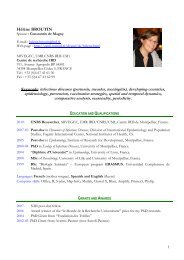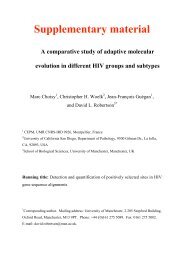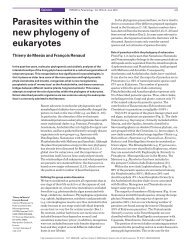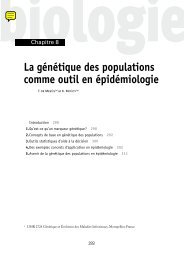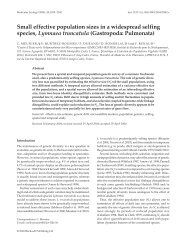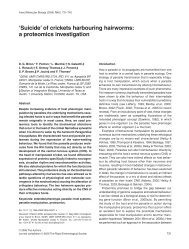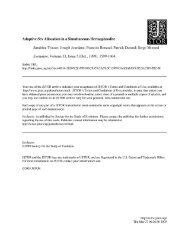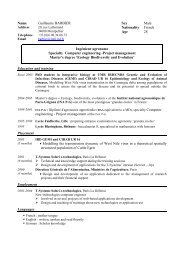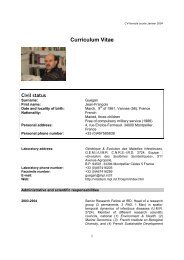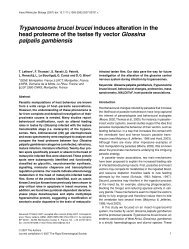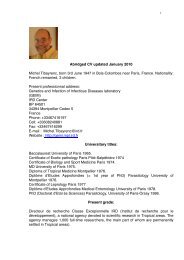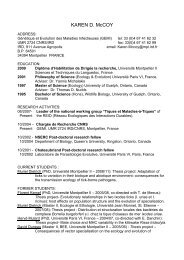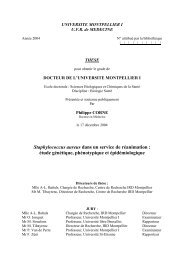écologie des virus influenza aviaires en Camargue - IRD
écologie des virus influenza aviaires en Camargue - IRD
écologie des virus influenza aviaires en Camargue - IRD
Create successful ePaper yourself
Turn your PDF publications into a flip-book with our unique Google optimized e-Paper software.
Annexe 2rates decrease significantly [24]. The impact of the parasite is greatest in autumn, wh<strong>en</strong> thebulk of leaf detritus <strong>en</strong>ters the streams, thus affecting the input of an important basalresource to the ecosystem. Similarly, nonlethal effects of tremato<strong>des</strong> on the intertidal mudsnails B. cumingi (see earlier section) are likely to alter <strong>en</strong>ergy transfer in littoral food websby shifting host population size structure, as well as habitat and resource use [15].Third, manipulative parasites can create completely novel trophic interactions, andthe exclusion of parasites from a community would affect food web structure moreprofoundly by removing other links as well. For example, cockles stranded on the sedim<strong>en</strong>tsurface of New Zealand intertidal mudflats because of heavy trematode infections in theirfoot (see Box 2) experi<strong>en</strong>ce nonlethal predation from wrasses: the fish crop the foot ofsurfaced cockles that try in vain to burrow at high tide [25]. This particular trophicrelationship exists exclusively because of parasites: unparasitized cockles are unaffected andremain buried under the sedim<strong>en</strong>ts out of the fish’s reach. Surfacestranded cockles are alsoexploited by other opportunistic predators such as whelks, adding to the total cockle biomassdiverted to other members of the food web solely because of manipulative parasites. Byincreasing the accessibility to prey that are normally difficult to capture, manipulativetrophically transmitted parasites are likely to <strong>en</strong>hance the trophic pot<strong>en</strong>tial of ecosystems. InCooking Lake and Hastings Lake in Alberta, most birds (and probably mammals) feed oninvertebrates that are at the water surface (those infected by the acanthocephalanPolymorphus paradoxus), but relatively few predators are suitable hosts [26]. Similarly, inFr<strong>en</strong>ch rivers, infection with acanthocephalans increases the vulnerability of Gammaruspulex (Crustacea, Amphipoda) to nonhost invertebrate predators [27]. Manipulativeparasites are likely to locally influ<strong>en</strong>ce the levels of both intra and interspecific competitionbetwe<strong>en</strong> predators, and h<strong>en</strong>ce their local community structure.Novel trophic relationships can ev<strong>en</strong> be initiated betwe<strong>en</strong> differ<strong>en</strong>t compartm<strong>en</strong>ts ofthe ecosystem. Hairworms which make their arthropod hosts (crickets and grasshoppers)jump into water (reproductive habitat of the parasite, see Figure 1.e) cause an allochthonousresource input (nutri<strong>en</strong>t transfer betwe<strong>en</strong> habitats [28]) at the forestriver interface. Indeed,this parasitic manipulation brings terrestrial arthropods into the diet of salmonid fish [29].Theoretical approaches also support the idea that manipulative parasites can haveimportant impacts on the structure, and possibly the stability, of natural food webs [3033].198



